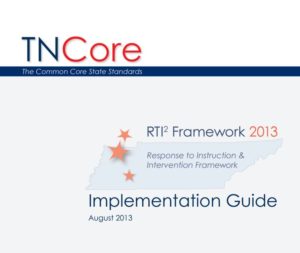Joshua is a second-grade student here in Tennessee. All his classmates are diving into books on their own, but Joshua is completely mystified by the squiggles on the page. His teacher is worried. She can’t give him the support he needs to catch up, but he’s not far enough behind to qualify for special education services. How can she help Joshua get back on track?
In the past, teachers didn’t have the tools or resources to help Joshua. He would continue struggling until he fell so far behind that he qualified for special education. But Tennessee teachers and policymakers refuse to watch students fall behind; in Fall 2014, they’re implementing a new program called Response to Intervention and Instruction (RTI2) in all Tennessee schools to identify struggling students, give them extra help, and monitor their progress.
 Tennessee teachers have high expectations for their students, especially now that Tennessee’s standards require complex reading and math skills. RTI2 gives students extra help to meet these high expectations, and gives teachers more resources to support them. Under RTI2, general education teachers work with instructional specialists, special education teachers, and administrators to give students the support they need. Some students need more help than others, so RTI2 has 3 levels, or “tiers,” of support.
Tennessee teachers have high expectations for their students, especially now that Tennessee’s standards require complex reading and math skills. RTI2 gives students extra help to meet these high expectations, and gives teachers more resources to support them. Under RTI2, general education teachers work with instructional specialists, special education teachers, and administrators to give students the support they need. Some students need more help than others, so RTI2 has 3 levels, or “tiers,” of support.
It all starts with high quality, instruction in the general education classroom. This tier 1 instruction meets the needs of 80-85 percent of students. In tier 1, teachers give an assessment to all their students to identify those that need extra help, like Joshua.
Joshua has been identified as a struggling reader. He continues receiving tier 1 instruction in his classroom, but also gets some additional support (called an “intervention”) in tier 2. These interventions are research-based and target the skills he needs to work on. Joshua’s team monitors his progress and uses this data to inform instruction. If Joshua responds well to the tier 2 support and catches up to his classmates, he returns to tier 1. If he continues to struggle, he moves up to tier 3.
In tier 3, Joshua receives more intensive interventions. His team continues to monitor his progress. If Joshua doesn’t improve after the three levels of intervention, it’s possible that he has a learning disability. He might be referred for a special education evaluation. However, the goal of RTI2 is always to help students catch up with their peers, not place them in special education.
Why It Works:
RTI2 emphasizes high quality, research-based instruction at all levels. This means using strong teaching practices that are proven to be effective. RTI2 sets clear goals based on the Common Core standards and measures student’s progress using assessments, allowing teachers to make data based decisions to best support their students. Finally, it gives students the individualized support they need right away. Tennessee is using RTI2 to follow their model of high expectations and high support for their students. Ultimately, RTI2 will help students soar!
For more information about Response to Instruction and Intervention in Tennessee, check out the online RTI Guide Book.
